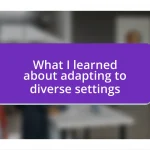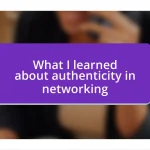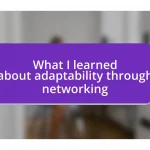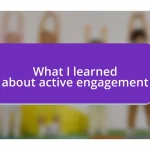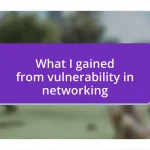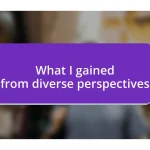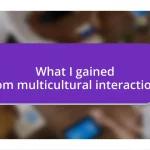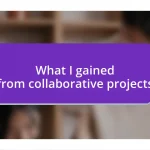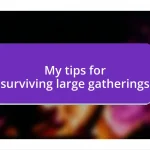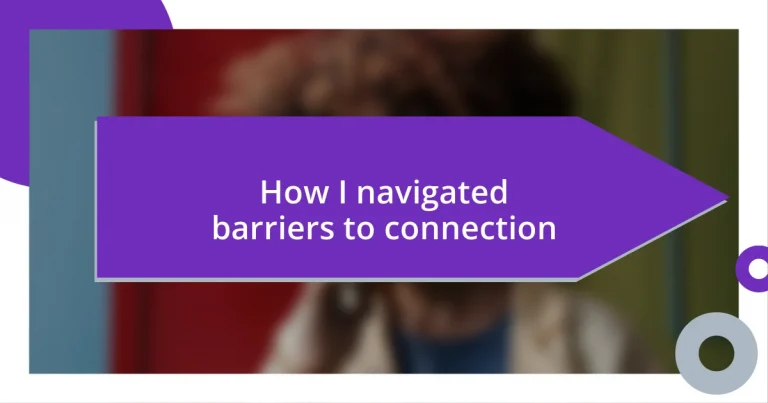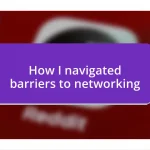Key takeaways:
- Internal and external barriers, like fear of vulnerability and cultural divides, significantly affect our ability to connect with others.
- Strategies such as setting small social goals, practicing vulnerability, and embracing active listening can enhance connection and communication.
- Creating a supportive environment and maintaining consistent communication fosters lasting relationships and meaningful connections.
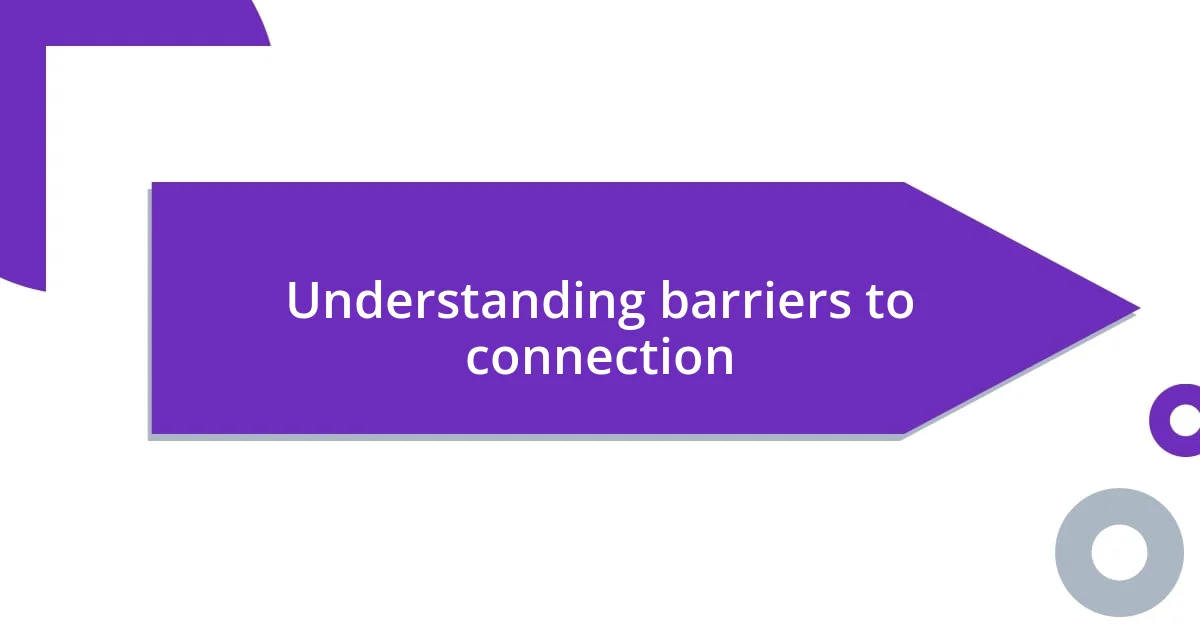
Understanding barriers to connection
Understanding barriers to connection often requires diving into our own experiences. I remember feeling isolated during a particularly challenging phase in life. I often asked myself, “Why is it so hard to reach out?” This struggle highlighted how internal barriers, like fear of rejection and vulnerability, can prevent us from forging meaningful connections.
Additionally, external factors can play a significant role in hindering connection. For instance, I once moved to a new city and felt overwhelmed by the sheer volume of people yet still felt incredibly lonely. Have you ever been surrounded by others yet felt utterly invisible? That insider perspective on external barriers—like socioeconomic differences or cultural divides—can create invisible walls that seem insurmountable.
It’s fascinating how communication styles can also act as a barrier. There was a time when I completely misunderstood a friend’s intention because of differences in how we expressed our feelings. This experience made me realize that understanding each other’s communication preferences is crucial. How often do we assume we’re on the same wavelength, only to discover we’re speaking different languages?
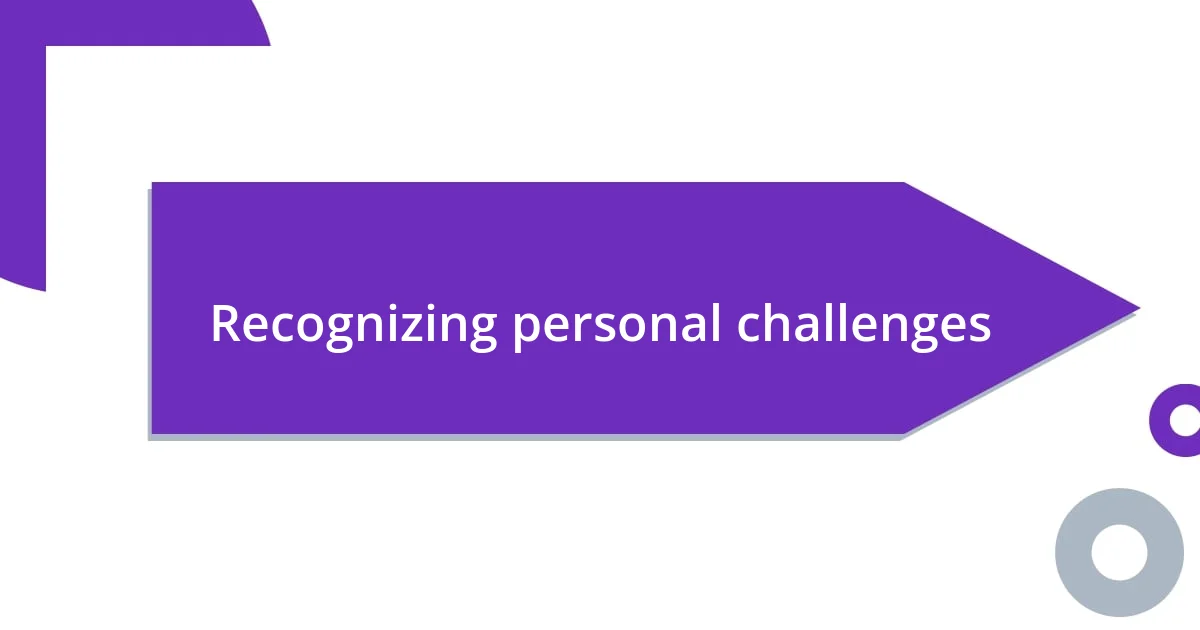
Recognizing personal challenges
Recognizing our personal challenges is the first step toward tackling barriers to connection. For instance, I used to underestimate the impact of my introverted nature. At social gatherings, while others mingled effortlessly, I often found myself retreating into my own thoughts, feeling out of place and anxious. It took time for me to understand that my discomfort was rooted in my personality, which craved depth in conversations rather than surface-level chit-chat.
Building on this reflection, here are some common personal challenges that can hinder connection:
- Fear of Vulnerability: Many of us hesitate to open up, fearing judgment or rejection.
- Low Self-Esteem: Doubting our worth can make us feel unworthy of meaningful connections.
- Past Trauma: Previous negative experiences can create emotional barriers that prevent us from trusting others.
- Overthinking: Constantly pondering “what if” scenarios can lead to inaction and missed opportunities for connection.
- Cultural Background: Different societal norms can make it challenging to understand and engage with others.
By acknowledging these challenges, we can take the necessary steps towards fostering authentic connections.
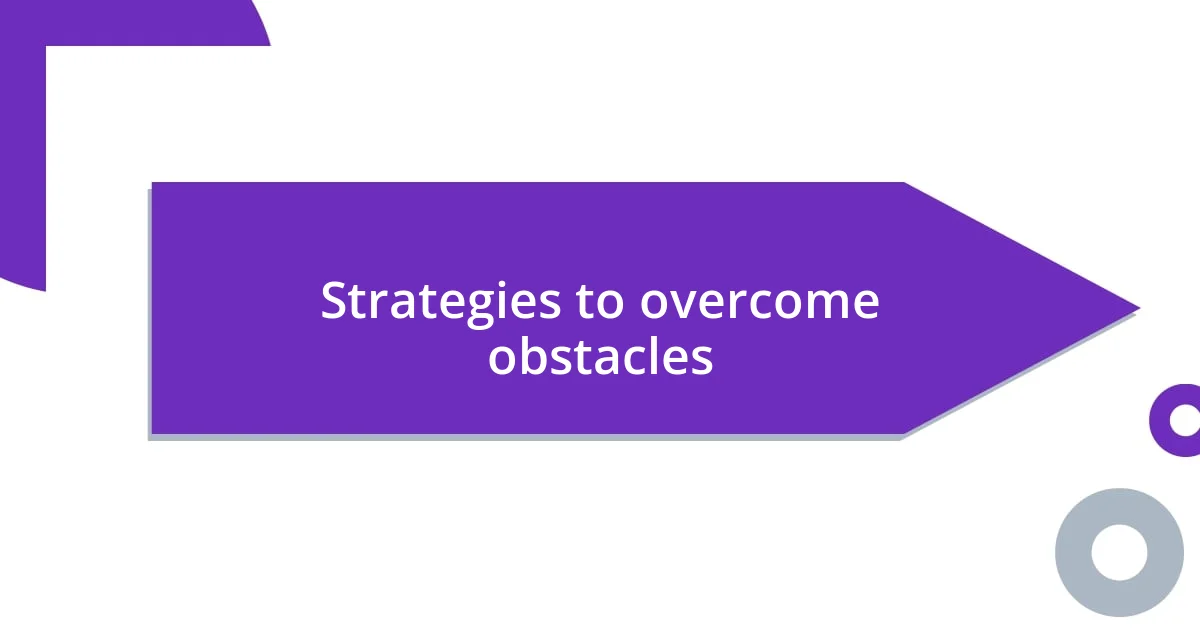
Strategies to overcome obstacles
One effective strategy I found helpful was setting small, achievable social goals. When I first moved to my new city, I aimed to strike up a conversation with at least one person each week. It might seem modest, but that little push made a world of difference. By breaking the task into smaller steps, I gradually built my confidence and expanded my social circle.
Another powerful approach was leaning into vulnerability. During a tough period, I decided to share my feelings with a close friend instead of keeping everything bottled up. To my surprise, my openness not only deepened our connection but also encouraged my friend to share her own struggles. This mutual exchange reminded me that vulnerability can foster a safe space for authentic connections.
Additionally, I embraced active listening as a key strategy. I used to find myself distracted during conversations, but I learned the importance of giving my full attention to others. By genuinely engaging and asking follow-up questions, I discovered that people appreciated being heard and valued. It transformed my interactions from superficial exchanges into meaningful dialogues.
| Strategy | Personal Anecdote |
|---|---|
| Small social goals | I aimed to chat with one person a week, which built my confidence over time. |
| Vulnerability | Sharing my feelings with a friend deepened our bond and encouraged her openness. |
| Active listening | Focusing on conversations changed my interactions from shallow to meaningful. |
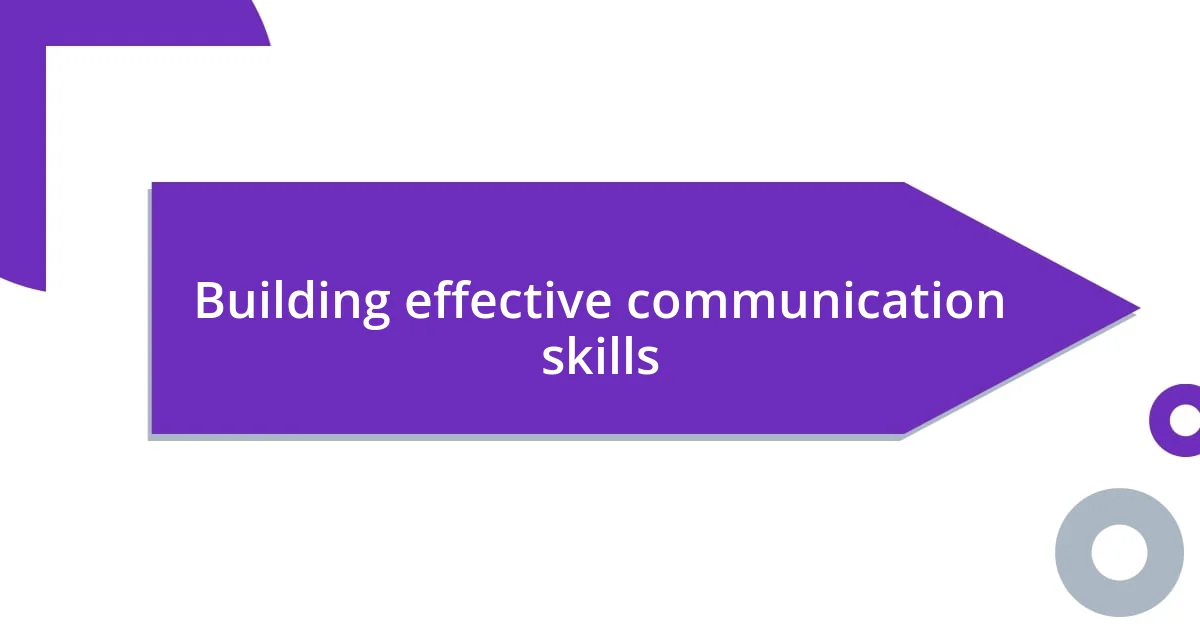
Building effective communication skills
Building effective communication skills is a journey that demands intentional effort. Reflecting on my experience, I recall a time when merely adjusting my body language transformed my interactions. Instead of crossing my arms or looking at my phone, I began maintaining eye contact and facing people more directly. This subtle shift not only made others feel more at ease but also encouraged me to engage more fully. Can you imagine the difference such small changes can make in your conversations?
One of the most enlightening moments for me occurred during a workshop on non-verbal communication. It challenged me to be aware of my tone and facial expressions. I discovered how easily a simple smile or a warm tone could break down barriers and foster connection. After that workshop, I made a conscious effort to incorporate positive gestures into my daily interactions. I couldn’t believe how much my relationships flourished, all from something so simple yet powerful.
Moreover, I realized that asking open-ended questions consistently sparked deeper conversations. I began experimenting by rephrasing my questions to invite more than just yes or no answers. Instead of asking, “Did you like the book?” I changed it to, “What did you find most intriguing about the book?” This shift not only piqued their curiosity but also encouraged me to listen actively, opening doors to rich exchanges I hadn’t experienced before. Isn’t it amazing how the right question can build bridges that previously seemed non-existent?
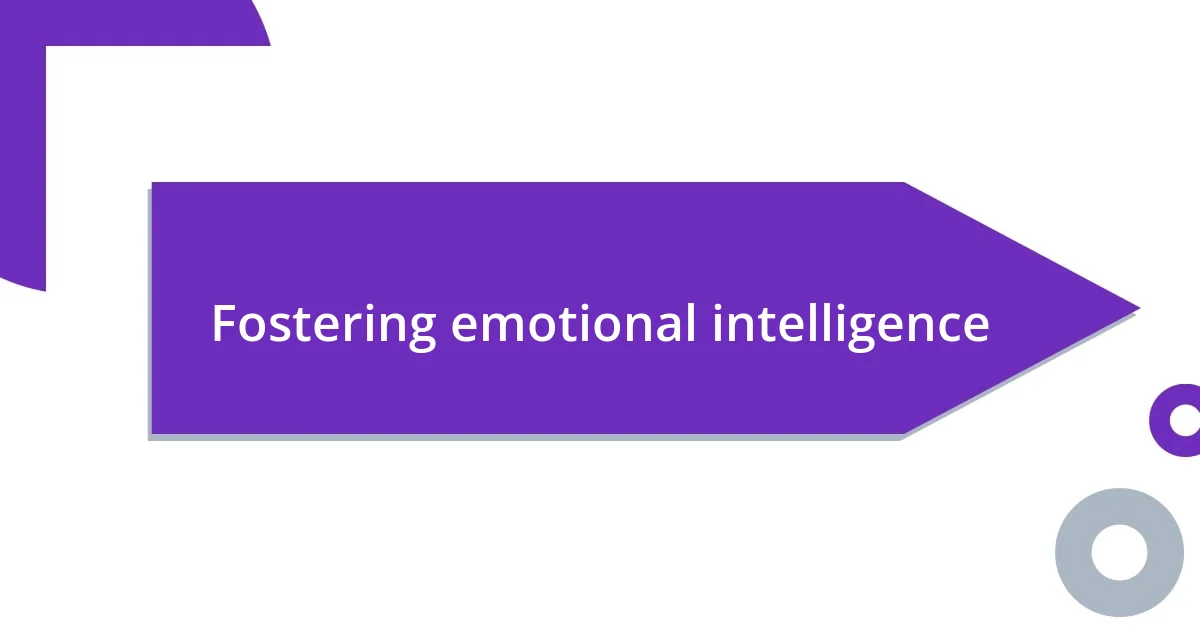
Fostering emotional intelligence
Fostering emotional intelligence has been a transformative journey for me. One memorable instance was when I took the time to reflect on my emotional reactions during heated discussions. I remember a particular argument with a colleague that left me feeling frustrated and misunderstood. Instead of simply reacting, I paused to identify my emotions and the underlying reasons for them. This shift allowed me to approach the conversation with a clearer mindset, ultimately leading to a more constructive dialogue. Isn’t it incredible how understanding our feelings can reshape interactions?
Another essential aspect was learning to empathize deeply with others’ experiences. I can recall a moment when a friend confided in me about her struggles with work-life balance. Instead of offering quick solutions, I focused on validating her feelings and shared my own similar experiences. This simple act of empathy not only strengthened our bond but also created a safe space for her to express herself. Have you ever noticed how a little compassion can change the dynamics of a conversation?
Additionally, I started to practice mindfulness to enhance my emotional awareness. I often found myself overwhelmed by daily stresses, which affected my mood and interactions. By incorporating brief mindfulness exercises, like deep breathing or a few moments of quiet reflection, I became more attuned to my emotions. This newfound awareness helped me respond thoughtfully in social situations rather than react impulsively. Wouldn’t you agree that mindfulness can be a game-changer in navigating emotional landscapes?
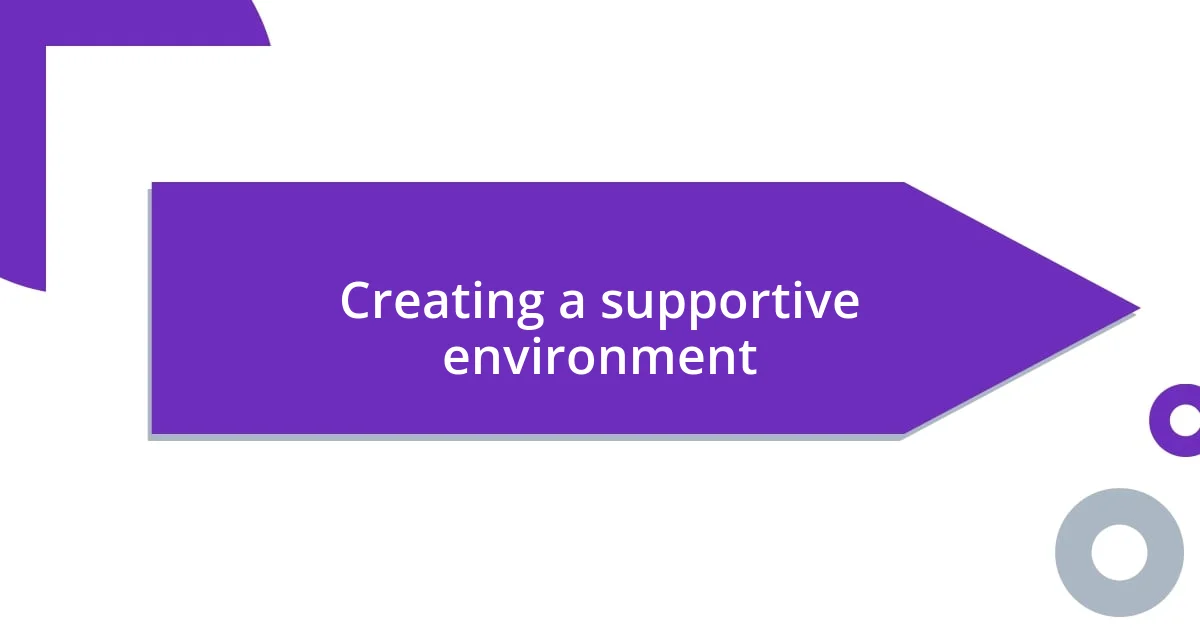
Creating a supportive environment
Creating a supportive environment is essential for meaningful connections. I remember an evening spent with a group of friends over dinner, where we set the tone by sharing our highs and lows from the week. It was a simple conversation starter, yet it opened the floodgates for genuine sharing. Have you ever noticed how vulnerability can cultivate a sense of safety among your peers?
In my experience, physical space plays a crucial role in fostering connection. I tend to prefer gatherings that aren’t too formal or crowded; a cozy living room or a quiet café can work wonders. Picture this: I once hosted a game night where the layout was relaxed, with everyone seated in a circle instead of at a table. This arrangement made it easier for us to maintain eye contact and engage in lively discussions. It’s fascinating how the right setting can encourage openness and camaraderie, isn’t it?
Moreover, I’ve found that actively encouraging each person to contribute can make a big difference. During a team meeting, I introduced a ’round-robin’ style of sharing, where everyone had a chance to voice their thoughts without interruption. I vividly remember how one quieter colleague surprised us all with a brilliant idea that reshaped our project. Creating an atmosphere where everyone feels valued not only boosts individual confidence but also enriches the collective experience. How empowering is it to witness someone shine in a supportive space?
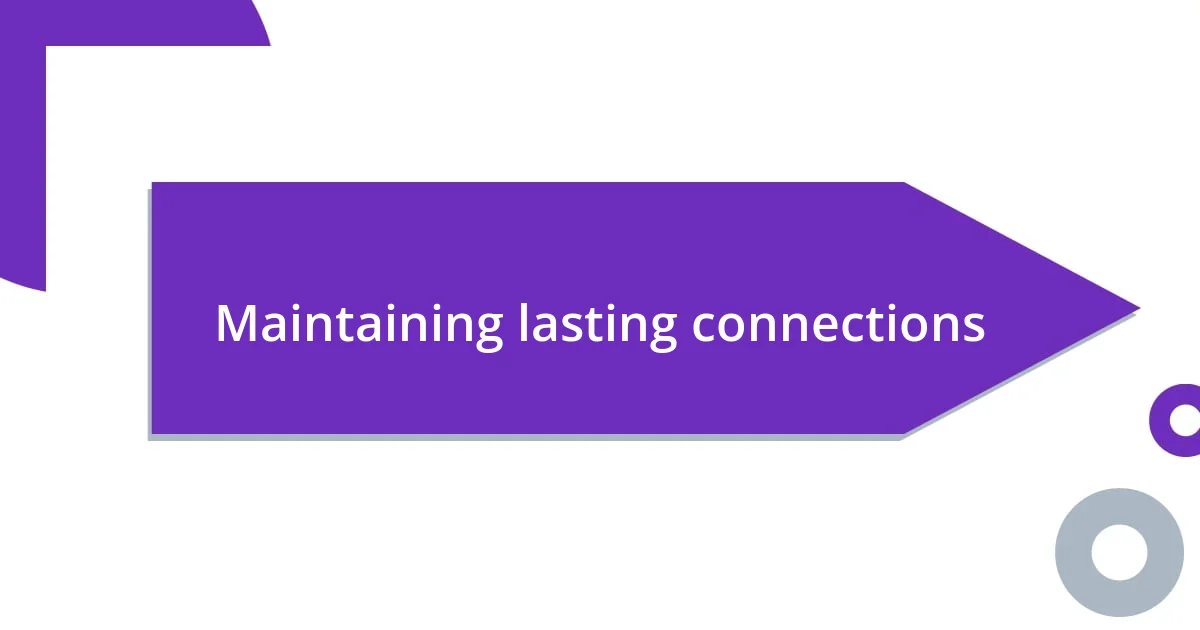
Maintaining lasting connections
One of the best ways I’ve found to maintain lasting connections is through consistent, intentional communication. I remember a period when a dear friend and I started sending each other weekly texts just to check in. These messages, often just a few lines long, kept us connected despite our busy lives. Have you ever noticed how a simple “How are you?” can sustain relationships over time?
Another insight from my journey is the importance of celebrating milestones together. I’ll never forget the joy of organizing a surprise birthday party for my sister. The excitement in the air as we collaborated with other friends to ensure everything was perfect truly deepened our bond. Sharing these special moments not only creates lasting memories but also reinforces our commitment to one another. Isn’t it wonderful how shared experiences can fortify connections?
I also learned that sometimes it’s the unexpected gestures that make the most impact. Recently, I decided to send a handwritten note to a mentor who influenced my career path. Her surprise and gratitude made me realize how rare those small, thoughtful gestures are today. Isn’t it interesting how such a simple act has the power to breathe life into a relationship? It’s these consistent efforts that, in my experience, turn casual acquaintances into lasting friendships.
